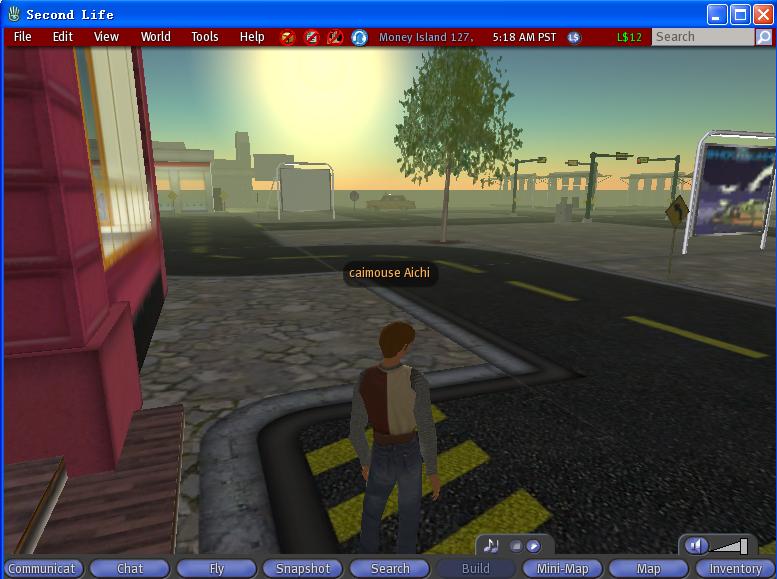第二人生的源码分析 12 天空显示的实现
Posted skiwnchh
tags:
篇首语:本文由小常识网(cha138.com)小编为大家整理,主要介绍了第二人生的源码分析 12 天空显示的实现相关的知识,希望对你有一定的参考价值。
在虚拟世界里,自然现象的实现是最需要实现的,比如天空的实现,以便反映是白天还是晚上,这样才逼真反映现实世界。在第二人生里实现的天空,还是比较好的,如下图所示:

蔡军生 2008/01/10 QQ:9073204 深圳
从上面的图片里,可以看到太阳在远处,并具有雾化的效果,这是早上太阳升起的效果。看到远处是浅蓝色的天空,与海边连接成一体。在室外场境的模拟中,最重要的就是天空体的实现。目前实现天空体有两种不同的实现方式:天体盒和天空穹。而第二人生里是采用天空盒的实现方式,这种方式是渲染的速度比较快,但纹理需要特别处理,才让人们看到的所有地方一样远的感觉。跟实现地面是一样的,都是使用网格和纹理来实现。下面就来通过代码仔细地分析怎么创建天空盒的网格,以及纹理的坐标设置。
#001
#002 BOOL LLVOSky::updateGeometry(LLDrawable *drawable)
#003 {
#004 if (mFace[FACE_REFLECTION] == NULL)
#005 {
#006 LLDrawPoolWater *poolp = (LLDrawPoolWater*) gPipeline.getPool(LLDrawPool::POOL_WATER);
#007 mFace[FACE_REFLECTION] = drawable->addFace(poolp, NULL);
#008 }
创建反射表面。
#009
#010 mCameraPosAgent = drawable->getPositionAgent();
#011 mEarthCenter.mV[0] = mCameraPosAgent.mV[0];
#012 mEarthCenter.mV[1] = mCameraPosAgent.mV[1];
#013
#014 LLVector3 v_agent[8];
#015 for (S32 i = 0; i < 8; ++i)
#016 {
#017 F32 x_sgn = (i&1) ? 1.f : -1.f;
#018 F32 y_sgn = (i&2) ? 1.f : -1.f;
#019 F32 z_sgn = (i&4) ? 1.f : -1.f;
#020 v_agent[i] = HORIZON_DIST*0.25f * LLVector3(x_sgn, y_sgn, z_sgn);
#021 }
#022
#023 LLStrider<LLVector3> verticesp;
#024 LLStrider<LLVector3> normalsp;
#025 LLStrider<LLVector2> texCoordsp;
#026 LLStrider<U32> indicesp;
#027 S32 index_offset;
#028 LLFace *face;
#029
下面开始创建天空盒的6个平面。
#030 for (S32 side = 0; side < 6; ++side)
#031 {
#032 face = mFace[FACE_SIDE0 + side];
#033
#034 if (face->mVertexBuffer.isNull())
#035 {
#036 face->setSize(4, 6);
设置每个表面有4个顶点构成,共有6个索引顶点。
#037 face->setGeomIndex(0);
#038 face->setIndicesIndex(0);
#039 face->mVertexBuffer = new LLVertexBuffer(LLDrawPoolSky::VERTEX_DATA_MASK, GL_STREAM_DRAW_ARB);
#040 face->mVertexBuffer->allocateBuffer(4, 6, TRUE);
上面分配顶点缓冲区和索引缓冲区。
#041
#042 index_offset = face->getGeometry(verticesp,normalsp,texCoordsp, indicesp);
#043
#044 S32 vtx = 0;
#045 S32 curr_bit = side >> 1; // 0/1 = Z axis, 2/3 = Y, 4/5 = X
#046 S32 side_dir = side & 1; // even - 0, odd - 1
#047 S32 i_bit = (curr_bit + 2) % 3;
#048 S32 j_bit = (i_bit + 2) % 3;
#049
#050 LLVector3 axis;
#051 axis.mV[curr_bit] = 1;
#052 face->mCenterAgent = (F32)((side_dir << 1) - 1) * axis * HORIZON_DIST;
#053
#054 vtx = side_dir << curr_bit;
#055 *(verticesp++) = v_agent[vtx];
#056 *(verticesp++) = v_agent[vtx | 1 << j_bit];
#057 *(verticesp++) = v_agent[vtx | 1 << i_bit];
#058 *(verticesp++) = v_agent[vtx | 1 << i_bit | 1 << j_bit];
上面计算4个顶点坐标。
#059
#060 *(texCoordsp++) = TEX00;
#061 *(texCoordsp++) = TEX01;
#062 *(texCoordsp++) = TEX10;
#063 *(texCoordsp++) = TEX11;
#064
设置4个顶点的纹理坐标。
#065 // Triangles for each side
#066 *indicesp++ = index_offset + 0;
#067 *indicesp++ = index_offset + 1;
#068 *indicesp++ = index_offset + 3;
#069
#070 *indicesp++ = index_offset + 0;
#071 *indicesp++ = index_offset + 3;
#072 *indicesp++ = index_offset + 2;
上面设置每个表面由两个三角形构成索引。
#073 }
#074 }
#075
#076 const LLVector3 &look_at = gCamera->getAtAxis();
#077 LLVector3 right = look_at % LLVector3::z_axis;
#078 LLVector3 up = right % look_at;
#079 right.normVec();
#080 up.normVec();
#081
#082 const static F32 elevation_factor = 0.0f/sResolution;
#083 const F32 cos_max_angle = cosHorizon(elevation_factor);
#084 mSun.setDraw(updateHeavenlyBodyGeometry(drawable, FACE_SUN, TRUE, mSun, cos_max_angle, up, right));
#085 mMoon.setDraw(updateHeavenlyBodyGeometry(drawable, FACE_MOON, FALSE, mMoon, cos_max_angle, up, right));
#086
#087 const F32 water_height = gAgent.getRegion()->getWaterHeight() + 0.01f;
#088 // gWorldPointer->getWaterHeight() + 0.01f;
#089 const F32 camera_height = mCameraPosAgent.mV[2];
#090 const F32 height_above_water = camera_height - water_height;
#091
#092 BOOL sun_flag = FALSE;
#093
#094 if (mSun.isVisible())
#095 {
#096 if (mMoon.isVisible())
#097 {
#098 sun_flag = look_at * mSun.getDirection() > 0;
#099 }
#100 else
#101 {
#102 sun_flag = TRUE;
#103 }
#104 }
#105
#106 if (height_above_water > 0)
#107 {
#108 #if 1 //1.9.1
#109 BOOL render_ref = gPipeline.getPool(LLDrawPool::POOL_WATER)->getVertexShaderLevel() == 0;
#110 #else
#111 BOOL render_ref = !(gPipeline.getVertexShaderLevel(LLPipeline::SHADER_ENVIRONMENT) >= LLDrawPoolWater::SHADER_LEVEL_RIPPLE);
#112 #endif
#113 if (sun_flag)
#114 {
#115 setDrawRefl(0);
#116 if (render_ref)
#117 {
#118 updateReflectionGeometry(drawable, height_above_water, mSun);
#119 }
#120 }
#121 else
#122 {
#123 setDrawRefl(1);
#124 if (render_ref)
#125 {
#126 updateReflectionGeometry(drawable, height_above_water, mMoon);
#127 }
#128 }
#129 }
#130 else
#131 {
#132 setDrawRefl(-1);
#133 }
#134
#135
#136 LLPipeline::sCompiles++;
#137 return TRUE;
#138 }
#139
上面计算太阳和月亮的出现位置以及光照效果。
通过上面的分析,了解天空体的网格创建,纹理坐标的设置,以及太阳、月亮的效果计算。
再分享一下我老师大神的人工智能教程吧。零基础!通俗易懂!风趣幽默!还带黄段子!希望你也加入到我们人工智能的队伍中来!https://blog.csdn.net/jiangjunshow
以上是关于第二人生的源码分析 12 天空显示的实现的主要内容,如果未能解决你的问题,请参考以下文章